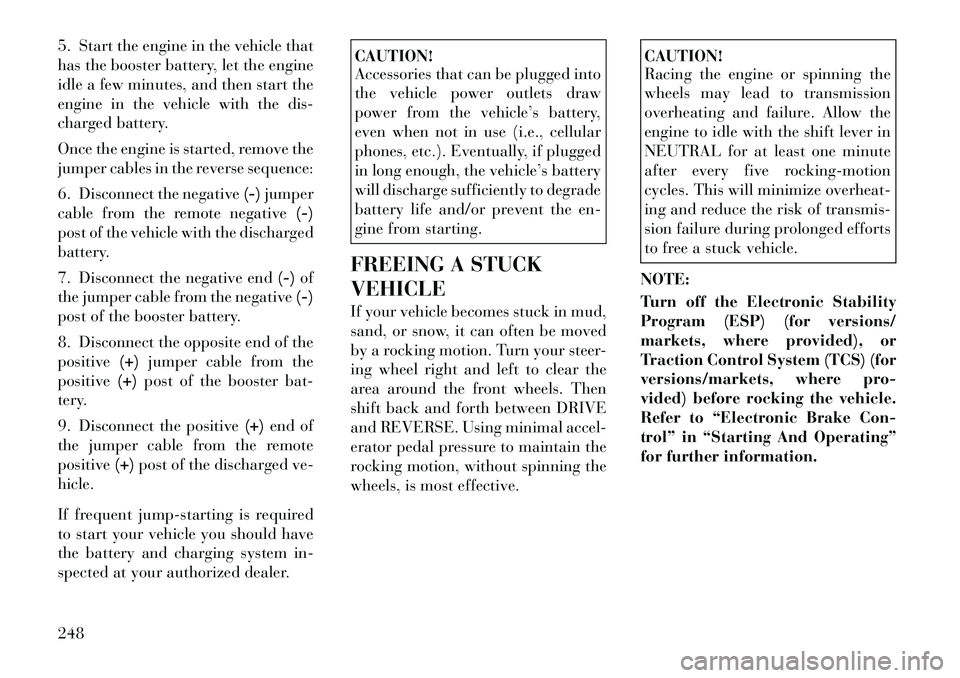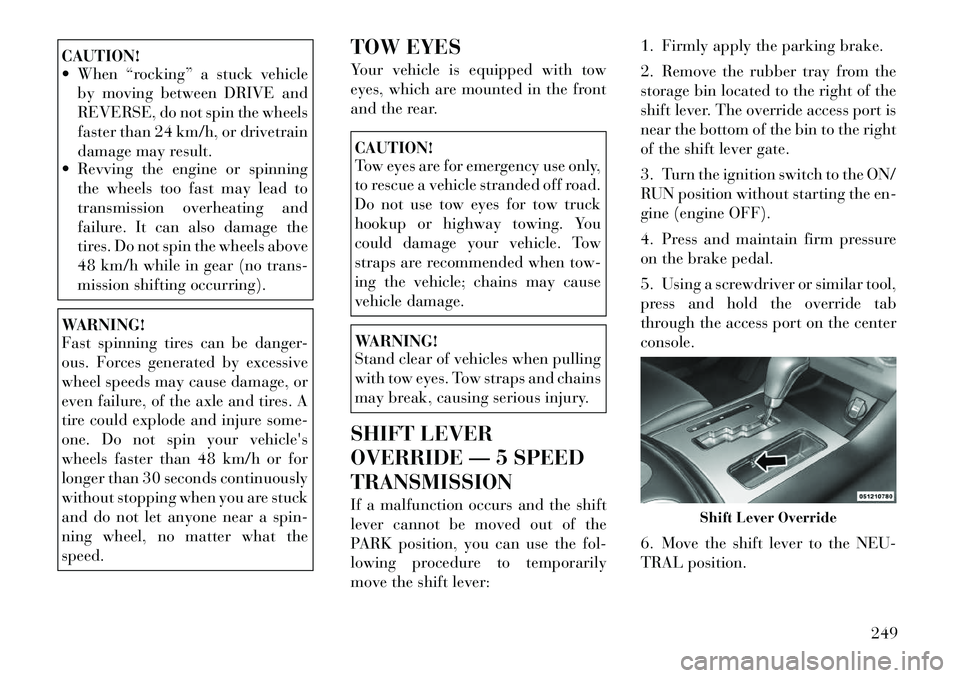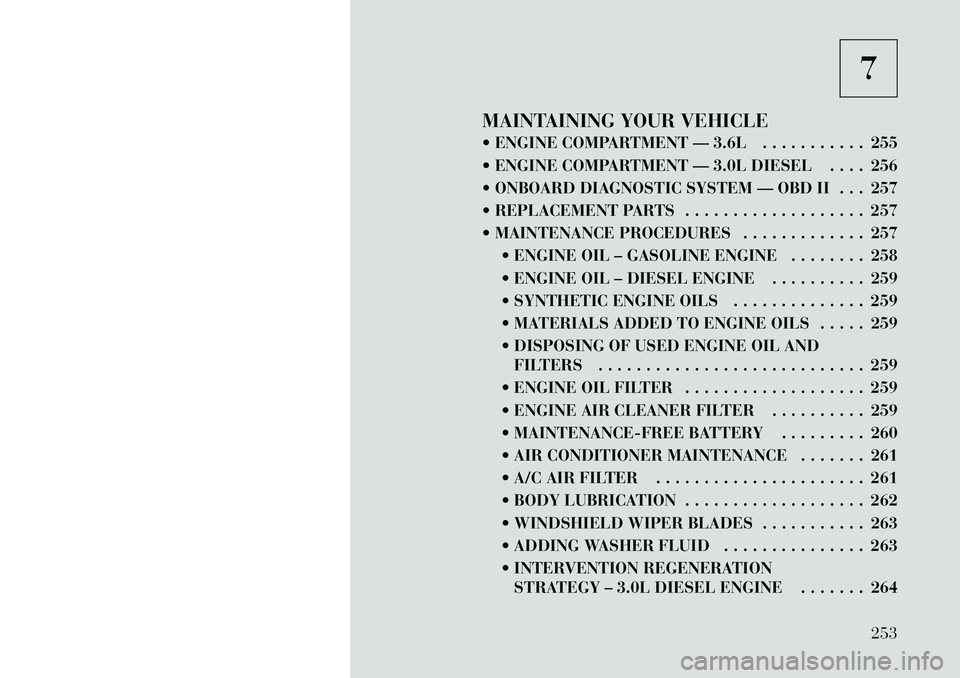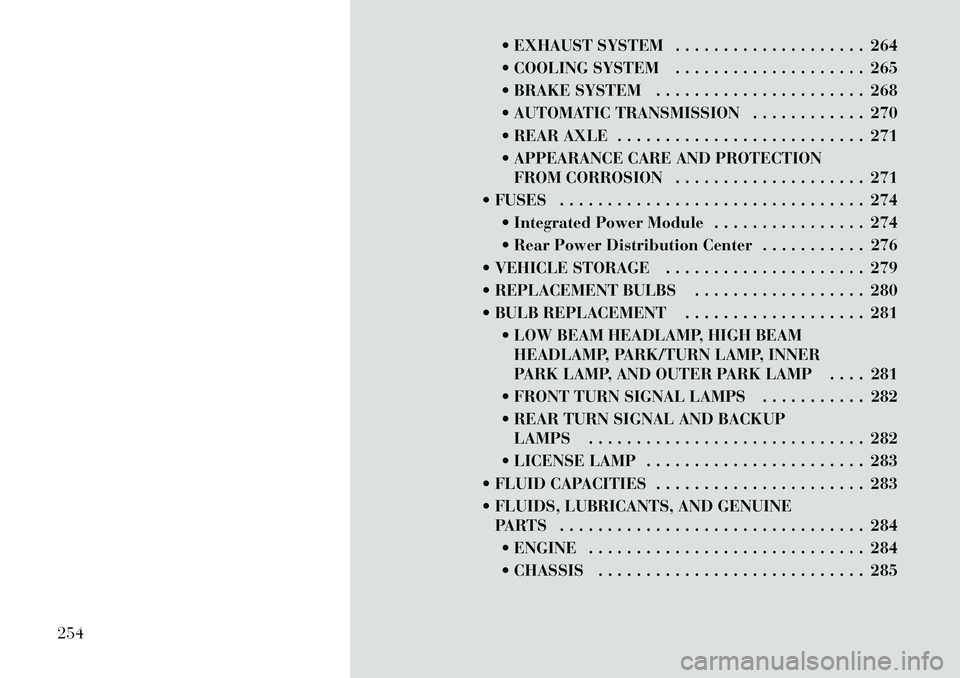Lancia Thema 2012 Owner handbook (in English)
Manufacturer: LANCIA, Model Year: 2012, Model line: Thema, Model: Lancia Thema 2012Pages: 316, PDF Size: 3.85 MB
Page 251 of 316

FIT kit in the vehicle storage location.
Quickly proceed to (D) “Drive Ve-
hicle”.CAUTION!
The metal end fitting from PowerPlug (8) may get hot after use, so
it should be handled carefully.
Failure to reinstall the cap on the
fitting at the end of the Sealant
Hose (6) can result in sealant con-
tacting your skin, clothing, and
the vehicle’s interior. It can also
result in sealant contacting inter-
nal TIREFIT kit components
which may cause permanent
damage to the kit.
(D) Drive Vehicle:
Immediately after injecting sealant
and inflating the tire, drive the vehicle
8 km or 10 minutes to ensure distri-
bution of the TIREFIT Sealant within
the tire. Do not exceed 88 km/h.
WARNING!
TIREFIT is not a permanent flat tire
repair. Have the tire inspected and
repaired or replaced after using
TIREFIT. Do not exceed 55 mph
(88 km/h) until the tire is repaired
or replaced. Failure to follow this
warning can result in injuries that
are serious or fatal to you, your pas-
sengers, and others around you.
(E) After Driving:
Pull over to a safe location. Refer to
“Whenever You Stop to Use TIRE-
FIT” before continuing.
1. Turn the Mode Select Knob (5) to
the Air Mode position.
2. Uncoil the power plug and insert
the plug into the vehicle's 12 Volt
power outlet.
3. Uncoil the Air Pump Hose (7)
(black in color) and screw the fitting
at the end of hose (7) onto the valve
stem.
4. Check the pressure in the tire by
reading the Pressure Gauge (3). If tire pressure is less than 1.3 Bar,
the tire is too badly damaged. Do not
attempt to drive the vehicle further.
Call for assistance.
If the tire pressure is 1.3 Bar or
higher:
1. Press the Power Button (4) to turn
on TIREFIT and inflate the tire to the
pressure indicated on the tire and
loading information label on the
driver
-side door opening.
NOTE:
If the tire becomes over-inflated,
press the Deflation Button to re-
duce the tire pressure to the rec-
ommended inflation pressure be-
fore continuing.
2. Disconnect the TIREFIT kit from
the valve stem, reinstall the cap on the
valve stem and unplug from 12 Volt
outlet.
3. Place the TIREFIT kit in its proper
storage area in the vehicle.
4. Have the tire inspected and re-
paired or replaced at the earliest op-
portunity at an authorized dealer or
tire service center.
245
Page 252 of 316

5. Replace the Sealant Bottle (1) and
Sealant Hose (6) assembly at your
authorized dealer as soon as possible.
Refer to “(F) Sealant Bottle and Hose
Replacement.”
NOTE:
When having the tire serviced, ad-
vise the authorized dealer or ser-
vice center that the tire has been
sealed using the TIREFIT service
kit.
(F) Sealant Bottle And Hose
Replacement:
1. Uncoil the Sealant Hose (6) (clear
in color).
2. Locate the round Sealant Bottle
release button in the recessed area
under the sealant bottle.
3. Press the Sealant Bottle release
button. The Sealant Bottle (1) will
pop up. Remove the bottle and dis-
pose of it accordingly.
4. Clean any remaining sealant from
the TIREFIT housing.
5. Position the new Sealant Bottle (1)
in the housing so that the Sealant
Hose (6) aligns with the hose slot inthe front of the housing. Press the
bottle into the housing. An audible
click will be heard indicating the
bottle is locked into place.
6. Verify that the cap is installed on
the fitting at the end of the Sealant
Hose (6) and return the hose to its
storage area (located on the bottom of
the air pump).
7. Return the TIREFIT kit to its stor-
age location in the vehicle.
JUMP-STARTING
PROCEDURES
If your vehicle has a discharged bat-
tery it can be jump-started using a set
of jumper cables and a battery in an-
other vehicle or by using a portable
battery booster pack. Jump-starting
can be dangerous if done improperly
so please follow the procedures in this
section carefully.
NOTE:
When using a portable battery
booster pack follow the manufac-
turer’s operating instructions and
precautions.
CAUTION!
Do not use a portable battery
booster pack or any other booster
source with a system voltage greater
than 12 Volts or damage to the bat-
tery, starter motor, alternator or
electrical system may occur.WARNING!
Do not attempt jump-starting if the
battery is frozen. It could rupture or
explode and cause personal injury.
PREPARATIONS FOR
JUMP-START
The battery is stored under an access
cover in the trunk. Remote battery
posts are located on the right side of
the engine compartment for jump-
starting.
NOTE:
The remote battery posts are
viewed by standing on the right
side of the vehicle looking over the
fender.
246
Page 253 of 316

Remote Battery PostsWARNING!
Take care to avoid the radiatorcooling fan whenever the hood is
raised. It can start anytime the
ignition switch is on. You can be
injured by moving fan blades.
Remove any metal jewelry such as
watch bands or bracelets that
might make an inadvertent elec-
trical contact. You could be seri-
ously injured.
Batteries contain sulfuric acid
that can burn your skin or eyes
and generate hydrogen gas which
is flammable and explosive. Keep
open flames or sparks away from
the battery. 1. Set the parking brake, shift the
automatic transmission into PARK
and turn the ignition to LOCK.
2. Turn off the heater, radio, and all
unnecessary electrical accessories.
3. If using another vehicle to jump-
start the battery, park the vehicle
within the jumper cables reach, set
the parking brake and make sure the
ignition is OFF.
WARNING!
Do not allow vehicles to touch each
other as this could establish a
ground connection and personal in-
jury could result.
JUMP-STARTING
PROCEDUREWARNING!
Failure to follow this procedure
could result in personal injury or
property damage due to battery ex-
plosion.
CAUTION!
Failure to follow these procedures
could result in damage to the charg-
ing system of the booster vehicle or
the discharged vehicle.
1. Connect the positive (+)end of the
jumper cable to the remote positive
(+) post of the discharged vehicle.
2. Connect the opposite end of the
positive (+)jumper cable to the posi-
tive (+)post of the booster battery.
3. Connect the negative end (-)of the
jumper cable to the negative (-)post
of the booster battery.
4. Connect the opposite end of the
negative (-)jumper cable to the re-
mote negative (-)post of the vehicle
with the discharged battery.WARNING!
Do not connect the cable to the nega-
tive post (-)of the discharged bat-
tery. The resulting electrical spark
could cause the battery to explode
and could result in personal injury.
1 — Remote Positive (+) Post
2 — Remote Negative (-) Post
247
Page 254 of 316

5. Start the engine in the vehicle that
has the booster battery, let the engine
idle a few minutes, and then start the
engine in the vehicle with the dis-
charged battery.
Once the engine is started, remove the
jumper cables in the reverse sequence:
6. Disconnect the negative(-)jumper
cable from the remote negative (-)
post of the vehicle with the discharged
battery.
7. Disconnect the negative end (-)of
the jumper cable from the negative (-)
post of the booster battery.
8. Disconnect the opposite end of the
positive (+)jumper cable from the
positive (+)post of the booster bat-
tery.
9. Disconnect the positive (+)end of
the jumper cable from the remote
positive (+)post of the discharged ve-
hicle.
If frequent jump-starting is required
to start your vehicle you should have
the battery and charging system in-
spected at your authorized dealer.
CAUTION!
Accessories that can be plugged into
the vehicle power outlets draw
power from the vehicle’s battery,
even when not in use (i.e., cellular
phones, etc.). Eventually, if plugged
in long enough, the vehicle’s battery
will discharge sufficiently to degrade
battery life and/or prevent the en-
gine from starting.
FREEING A STUCK
VEHICLE
If your vehicle becomes stuck in mud,
sand, or snow, it can often be moved
by a rocking motion. Turn your steer-
ing wheel right and left to clear the
area around the front wheels. Then
shift back and forth between DRIVE
and REVERSE. Using minimal accel-
erator pedal pressure to maintain the
rocking motion, without spinning the
wheels, is most effective.
CAUTION!
Racing the engine or spinning the
wheels may lead to transmission
overheating and failure. Allow the
engine to idle with the shift lever in
NEUTRAL for at least one minute
after every five rocking-motion
cycles. This will minimize overheat-
ing and reduce the risk of transmis-
sion failure during prolonged efforts
to free a stuck vehicle.
NOTE:
Turn off the Electronic Stability
Program (ESP) (for versions/
markets, where provided), or
Traction Control System (TCS) (for
versions/markets, where pro-
vided) before rocking the vehicle.
Refer to “Electronic Brake Con-
trol” in “Starting And Operating”
for further information.
248
Page 255 of 316

CAUTION!
When “rocking” a stuck vehicleby moving between DRIVE and
REVERSE, do not spin the wheels
faster than 24 km/h, or drivetrain
damage may result.
Revving the engine or spinning
the wheels too fast may lead to
transmission overheating and
failure. It can also damage the
tires. Do not spin the wheels above
48 km/h while in gear (no trans-
mission shifting occurring).WARNING!
Fast spinning tires can be danger-
ous. Forces generated by excessive
wheel speeds may cause damage, or
even failure, of the axle and tires. A
tire could explode and injure some-
one. Do not spin your vehicle's
wheels faster than 48 km/h or for
longer than 30 seconds continuously
without stopping when you are stuck
and do not let anyone near a spin-
ning wheel, no matter what the
speed. TOW EYES
Your vehicle is equipped with tow
eyes, which are mounted in the front
and the rear.
CAUTION!
Tow eyes are for emergency use only,
to rescue a vehicle stranded off road.
Do not use tow eyes for tow truck
hookup or highway towing. You
could damage your vehicle. Tow
straps are recommended when tow-
ing the vehicle; chains may cause
vehicle damage.WARNING!
Stand clear of vehicles when pulling
with tow eyes. Tow straps and chains
may break, causing serious injury.
SHIFT LEVER
OVERRIDE — 5 SPEED
TRANSMISSION
If a malfunction occurs and the shift
lever cannot be moved out of the
PARK position, you can use the fol-
lowing procedure to temporarily
move the shift lever: 1. Firmly apply the parking brake.
2. Remove the rubber tray from the
storage bin located to the right of the
shift lever. The override access port is
near the bottom of the bin to the right
of the shift lever gate.
3. Turn the ignition switch to the ON/
RUN position without starting the en-
gine (engine OFF).
4. Press and maintain firm pressure
on the brake pedal.
5. Using a screwdriver or similar tool,
press and hold the override tab
through the access port on the center
console.
6. Move the shift lever to the NEU-
TRAL position.
Shift Lever Override
249
Page 256 of 316

7. The vehicle may then be started in
NEUTRAL.
8. Reinstall the rubber tray in the
storage bin.
MANUAL PARK
RELEASE — 8 SPEED
TRANSMISSION (3.6L
Engine)WARNING!
Always secure your vehicle by fully
applying the parking brake, before
activating the Manual Park Release.
Activating the Manual Park Release
will allow your vehicle to roll away if
it is not secured by the parking
brake or by proper connection to a
tow vehicle. Activating the Manual
Park Release on an unsecured ve-
hicle could lead to serious injury or
death for those in or around the ve-
hicle.
In order to push or tow the vehicle in
cases where the transmission will not
shift out of PARK (such as a dead
battery), a Manual Park Release is
available. Follow these steps to use the Manual
Park Release:
NOTE:
To prevent the vehicle from rolling
unintentionally, firmly apply the
parking brake.
1. Remove the console storage bin to
access the Manual Park Release lever.
2. Using a small screwdriver or simi-
lar tool, fish the tether strap up
through the opening in the console
base.
3. Insert the screwdriver into the slot
in the center of the lever, and disen-
gage the spring steel lever locking tab
by pushing it to the right.
4. While holding the locking tab in
the disengaged position, pull the
tether strap to rotate the lever up and
rearward, until it locks in place in the
vertical position. The vehicle is now
out of PARK and can be towed. Re-
lease the parking brake only when the
vehicle is securely connected to a tow
vehicle.
Console Storage Bin
Locking TabTether Strap
250
Page 257 of 316

To Reset The Manual Park Re-
lease:
1. Push the latch (at the base of the
lever, on the rear side) rearward
(away from the lever) to unlatch the
lever.2. Rotate the Manual Park Release
lever forward and down, to its original
position, until the locking tab snaps
into place to secure the lever.
3. Pull up gently on the tether strap
to confirm that the lever is locked in
its stowed position.4. Tuck the tether strap into the base
of the console. Reinstall the console
storage bin.
TOWING A DISABLED VEHICLE
Towing Condition Wheels OFF the Ground ALL MODELS
Flat Tow NONEIf transmission is operable:
Transmission in
NEUTRAL
48 km/h maxspeed
24 km maxdistance (5-speed trans)
48 km maxdistance (8-speed trans)
Wheel Lift
Front
Rear OK
Flatbed ALLBEST METHOD
Proper towing or lifting equipment is
required to prevent damage to your
vehicle. Use only tow bars and other
equipment designed for the purpose,
following equipment manufacturer’s
instructions. Use of safety chains is
mandatory. Attach a tow bar or other
towing device to main structural
members of the vehicle, not to bum-
pers or associated brackets. State and
local laws applying to vehicles under
tow must be observed. If you must use the accessories (wip-
ers, defrosters, etc.) while being
towed, the ignition must be in the
ON/RUN position, not the ACC posi-
tion.
If the
vehicle's battery is discharged,
see “Shift Lever Override” in “What
To Do In Emergencies” for instruc-
tions on shifting the automatic trans-
mission out of the PARK position for
towing.
CAUTION!
Do not use sling type equipment when towing. Damage to the fas-
cia will occur.
When securing the vehicle to a
flatbed truck, do not attach to
front or rear suspension compo-
nents. Damage to your vehicle
may result from improper towing.
(Continued)
251
Page 258 of 316

CAUTION!(Continued)
Do not push or tow this vehicle
with another vehicle as damage to
the bumper fascia and transmis-
sion may result.
If the vehicle being towed requires
steering. the ignition switch must
be in the ON/RUN position, not
the LOCK or ACC positions.
The manufacturer does not recom-
mend that you tow this vehicle on a
tow dolly. Vehicle damage may occur.
The manufacturer recommends tow-
ing your vehicle with all four wheels
OFF the ground using a flatbed.
If flatbed equipment is not available,
and the transmission is operable, the
vehicle may be flat towed (with all
four wheels on the ground) under the
following conditions:
The shift lever must be in NEU- TRAL. The distance to be traveled must
not exceed 24 km for 5-speed
transmission, or 48 km for 8-speed
transmission.
The towing speed must not exceed 48 km/h.
If the transmission is not operable, or
the vehicle must be towed faster than
48 km/h or farther than 24 km for
5-speed transmission, or 48 km for
8-speed transmission, tow with the
rear wheels OFF the ground (on a
flatbed, or with the rear wheels raised
using a wheel lift and the transmission
in NEUTRAL).
CAUTION!
Failure to follow these towing meth-
ods can cause severe transmission
damage. Such damage is not covered
by the New Vehicle Limited War-
ranty. Without The Ignition Key
Special care must be taken when the
vehicle is towed with the ignition in
the OFF position. The only approved
method of towing without the ignition
key is with a flatbed truck. Proper
towing equipment is necessary to pre-
vent damage to the vehicle.
252
Page 259 of 316

7
MAINTAINING YOUR VEHICLE
ENGINE COMPARTMENT — 3.6L . . . . . . . . . . . 255
ENGINE COMPARTMENT — 3.0L DIESEL . . . . 256
ONBOARD DIAGNOSTIC SYSTEM — OBD II . . . 257
REPLACEMENT PARTS . . . . . . . . . . . . . . . . . . . 257
MAINTENANCE PROCEDURES . . . . . . . . . . . . . 257 ENGINE OIL – GASOLINE ENGINE . . . . . . . . 258
ENGINE OIL – DIESEL ENGINE . . . . . . . . . . 259
SYNTHETIC ENGINE OILS . . . . . . . . . . . . . . 259
MATERIALS ADDED TO ENGINE OILS . . . . . 259
DISPOSING OF USED ENGINE OIL ANDFILTERS . . . . . . . . . . . . . . . . . . . . . . . . . . . . 259
ENGINE OIL FILTER . . . . . . . . . . . . . . . . . . . 259
ENGINE AIR CLEANER FILTER . . . . . . . . . . 259
MAINTENANCE-FREE BATTERY . . . . . . . . . 260
AIR CONDITIONER MAINTENANCE . . . . . . . 261
A/C AIR FILTER . . . . . . . . . . . . . . . . . . . . . . 261
BODY LUBRICATION . . . . . . . . . . . . . . . . . . . 262
WINDSHIELD WIPER BLADES . . . . . . . . . . . 263
ADDING WASHER FLUID . . . . . . . . . . . . . . . 263
INTERVENTION REGENERATION STRATEGY – 3.0L DIESEL ENGINE . . . . . . . 264
253
Page 260 of 316

EXHAUST SYSTEM . . . . . . . . . . . . . . . . . . . . 264
COOLING SYSTEM . . . . . . . . . . . . . . . . . . . . 265
BRAKE SYSTEM . . . . . . . . . . . . . . . . . . . . . . 268
AUTOMATIC TRANSMISSION . . . . . . . . . . . . 270
REAR AXLE . . . . . . . . . . . . . . . . . . . . . . . . . . 271
APPEARANCE CARE AND PROTECTIONFROM CORROSION . . . . . . . . . . . . . . . . . . . . 271
FUSES . . . . . . . . . . . . . . . . . . . . . . . . . . . . . . . . 274 Integrated Power Module . . . . . . . . . . . . . . . . 274
Rear Power Distribution Center . . . . . . . . . . . 276
VEHICLE STORAGE . . . . . . . . . . . . . . . . . . . . . 279
REPLACEMENT BULBS . . . . . . . . . . . . . . . . . . 280
BULB REPLACEMENT . . . . . . . . . . . . . . . . . . . 281 LOW BEAM HEADLAMP, HIGH BEAMHEADLAMP, PARK/TURN LAMP, INNER
PARK LAMP, AND OUTER PARK LAMP . . . . 281
FRONT TURN SIGNAL LAMPS . . . . . . . . . . . 282
REAR TURN SIGNAL AND BACKUP LAMPS . . . . . . . . . . . . . . . . . . . . . . . . . . . . . 282
LICENSE LAMP . . . . . . . . . . . . . . . . . . . . . . . 283
FLUID CAPACITIES . . . . . . . . . . . . . . . . . . . . . . 283
FLUIDS, LUBRICANTS, AND GENUINE PARTS . . . . . . . . . . . . . . . . . . . . . . . . . . . . . . . . 284
ENGINE . . . . . . . . . . . . . . . . . . . . . . . . . . . . . 284
CHASSIS . . . . . . . . . . . . . . . . . . . . . . . . . . . . 285
254